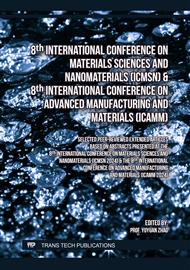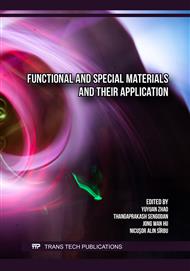p.3
p.9
p.15
p.21
p.27
p.37
p.43
p.49
Study of the Photocatalytic Efficiencies and Characteristics of Cu Doped TiO2 Coating on Reticulated Stainless Steel Mesh
Abstract:
This study involves the photocatalytic degradation of methylene blue (MB) under visible light using reticulated stainless steel that is coated with copper-doped TiO2. Steel meshes of three different grades are used in the experiment: 50 mesh, 120 mesh and 400 mesh. The coating process coats an average of 0.3 mg/cm2 of Cu–TiO2 on the 50 mesh and the 120 mesh and 0.2 mg/cm2 on the 400 mesh. SEM and XRD characterization show that the roughness of the mesh wire surface increases as the amount of coating is increased. All three types of mesh remove approximately 50% of MB, when coated with 1 mg/cm2 of CuO-TiO2. When the amount of coating is increased to 2.5 mg/cm2, the order for the photocatalytic degradation of MB for the three meshes is 120 mesh (93%) > 400 mesh (91%) > 50 mesh (86%). However, when the amount of coating is further increased to 2.5 mg/cm2, there is no significant difference between the three mesh groups, in terms of MB residue. The study demonstrates that the photocatalytic efficiency is affected by the surface area and thickness of the membrane that forms over the mesh openings.
Info:
Periodical:
Pages:
9-14
Citation:
Online since:
December 2024
Authors:
Price:
Сopyright:
© 2024 Trans Tech Publications Ltd. All Rights Reserved
Share:
Citation:



